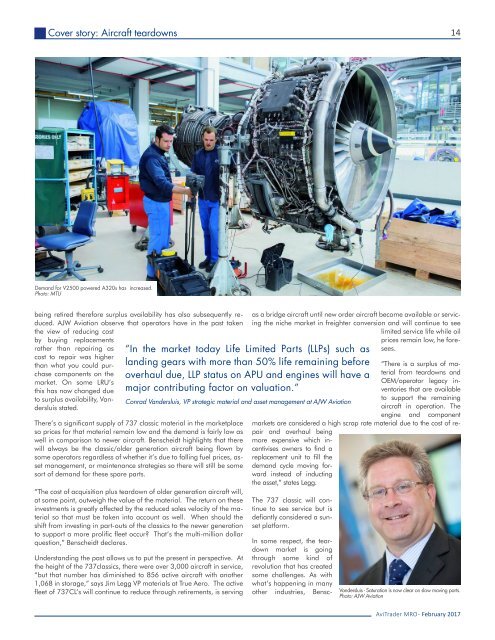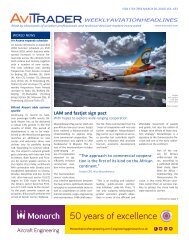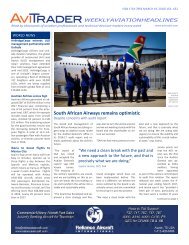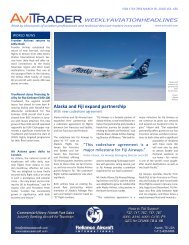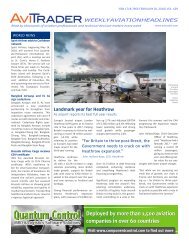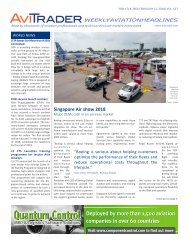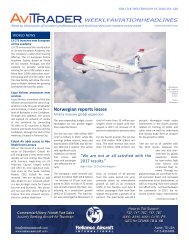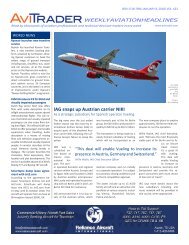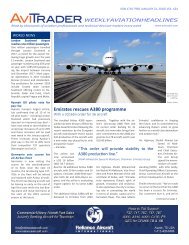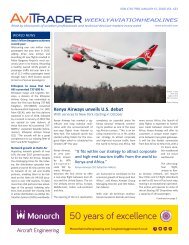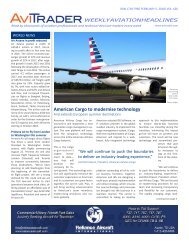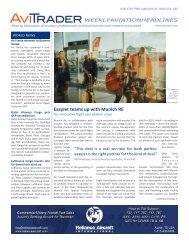AviTrader_Monthly_MRO_e-Magazine_2017-02
AviTrader_Monthly_MRO_e-Magazine_2017-02
AviTrader_Monthly_MRO_e-Magazine_2017-02
You also want an ePaper? Increase the reach of your titles
YUMPU automatically turns print PDFs into web optimized ePapers that Google loves.
Cover story: Aircraft teardowns<br />
14<br />
Demand for V2500 powered A320s has increased.<br />
Photo: MTU<br />
being retired therefore surplus availability has also subsequently reduced.<br />
AJW Aviation observe that operators have in the past taken<br />
the view of reducing cost<br />
by buying replacements<br />
rather than repairing as<br />
cost to repair was higher<br />
than what you could purchase<br />
components on the<br />
market. On some LRU’s<br />
this has now changed due<br />
to surplus availability, Vandersluis<br />
stated.<br />
There’s a significant supply of 737 classic material in the marketplace<br />
so prices for that material remain low and the demand is fairly low as<br />
well in comparison to newer aircraft. Benscheidt highlights that there<br />
will always be the classic/older generation aircraft being flown by<br />
some operators regardless of whether it’s due to falling fuel prices, asset<br />
management, or maintenance strategies so there will still be some<br />
sort of demand for these spare parts.<br />
“The cost of acquisition plus teardown of older generation aircraft will,<br />
at some point, outweigh the value of the material. The return on these<br />
investments is greatly affected by the reduced sales velocity of the material<br />
so that must be taken into account as well. When should the<br />
shift from investing in part-outs of the classics to the newer generation<br />
to support a more prolific fleet occur? That’s the multi-million dollar<br />
question,” Benscheidt declares.<br />
Understanding the past allows us to put the present in perspective. At<br />
the height of the 737classics, there were over 3,000 aircraft in service,<br />
“but that number has diminished to 856 active aircraft with another<br />
1,068 in storage,” says Jim Legg VP materials at True Aero. The active<br />
fleet of 737CL’s will continue to reduce through retirements, is serving<br />
as a bridge aircraft until new order aircraft become available or servicing<br />
the niche market in freighter conversion and will continue to see<br />
limited service life while oil<br />
prices remain low, he foresees.<br />
“In the market today Life Limited Parts (LLPs) such as<br />
landing gears with more than 50% life remaining before<br />
overhaul due, LLP status on APU and engines will have a<br />
major contributing factor on valuation.”<br />
Conrad Vandersluis, VP strategic material and asset management at AJW Aviation<br />
“There is a surplus of material<br />
from teardowns and<br />
OEM/operator legacy inventories<br />
that are available<br />
to support the remaining<br />
aircraft in operation. The<br />
engine and component<br />
markets are considered a high scrap rate material due to the cost of repair<br />
and overhaul being<br />
more expensive which incentivises<br />
owners to find a<br />
replacement unit to fill the<br />
demand cycle moving forward<br />
instead of inducting<br />
the asset,” states Legg.<br />
The 737 classic will continue<br />
to see service but is<br />
defiantly considered a sunset<br />
platform.<br />
In some respect, the teardown<br />
market is going<br />
through some kind of<br />
revolution that has created<br />
some challenges. As with<br />
what’s happening in many<br />
other industries, Bensc-<br />
Vandersluis - Saturation is now clear on slow moving parts.<br />
Photo: AJW Aviation<br />
<strong>AviTrader</strong> <strong>MRO</strong> - February <strong>2017</strong>


